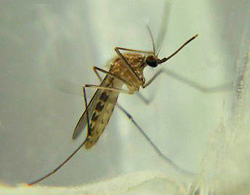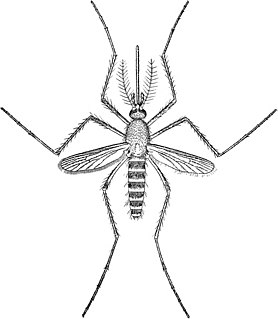Related Research Articles

A mosquito is any member of a group of about 3,500 species of small insects belonging to the order Diptera (flies). Within Diptera, mosquitoes constitute the family Culicidae. The word "mosquito" is Spanish and Portuguese for "little fly". Mosquitoes have a slender segmented body, one pair of wings, one pair of halteres, three pairs of long hair-like legs, and elongated mouthparts.

Culex is a genus of mosquitoes, several species of which serve as vectors of one or more important diseases of birds, humans, and other animals. The diseases they vector include arbovirus infections such as West Nile virus, Japanese encephalitis, or St. Louis encephalitis, but also filariasis and avian malaria. They occur worldwide except for the extreme northern parts of the temperate zone, and are the most common form of mosquito encountered in some major U.S. cities, such as Los Angeles.
Culex (Culex) tritaeniorhynchus is a species of mosquito and is the main vector of the disease Japanese encephalitis. This mosquito is a native of northern Asia, and parts of Africa. Females target large animals for blood extraction, including cattle and swine, and are strongly anthropophilic.

The discipline of medical entomology, or public health entomology, and also veterinary entomology is focused upon insects and arthropods that impact human health. Veterinary entomology is included in this category, because many animal diseases can "jump species" and become a human health threat, for example, bovine encephalitis. Medical entomology also includes scientific research on the behavior, ecology, and epidemiology of arthropod disease vectors, and involves a tremendous outreach to the public, including local and state officials and other stake holders in the interest of public safety. Medical Entomologists are employed by private and public universities, private industries, and federal, state, and local government agencies, including all three branches of the US military - who hire medical entomologists to protect the troops from infectious diseases that can be transmitted by arthropods. Historically, during wars, more people have died due to insect-transmitted diseases, than to all the battle injuries combined.

The London Underground mosquito is a form of mosquito in the genus Culex. It is found in the London Underground railway system as its name suggests, but has a worldwide distribution and long predates the existence of the London Underground. It was first described as a distinct species from Egyptian specimens by the biologist Peter Forsskål (1732–1763). He named this mosquito Culex molestus due to its voracious biting, but later biologists renamed it Culex pipiens f. molestus because there were no morphological differences between it and Culex pipiens. Notably, this mosquito assaulted Londoners sleeping in the Underground during the Blitz, although similar populations were long known.

Culex annulirostris, commonly known as the common banded mosquito, is an insect native to Australia, Fiji, Micronesia, the Philippines and Indonesia. It is regarded as a serious pest species throughout its range.

Donald Henry Colless, also known as Vale Don Colless or simply Don Colless, was an Australian entomologist. He was an authority on true flies (Diptera).
Culex vishnui is a mosquito belonging to the Culicidae family. It is the most common vector (carrier) of the Japanese encephalitis virus (JEV) in India, Sri Lanka, Thailand, and Sarawak.
Pylore Krishnaier Rajagopalan is an Indian vector control scientist, biologist and acarologist, known for his pioneering contributions to the control programmes against vector-borne diseases in India.[1] He is a former director of the Indian Council of Medical Research managed Vector Control Research Centre, Pondicherry.[2][3] He graduated in 1949 from the Banaras Hindu University and obtained a Masters in Zoology with University First Rank there itself in 1951. In 1952 he joined the fledgling Virus Research Centre in Pune, and worked under the supervision of some of the finest vector control specialists such as Dr T Ramachandra Rao. In recognition of his outstanding work as a young research scientist, in 1957 he was awarded a Fellowship by the Rockefeller Foundation to pursue a Master's program in Public Health from the University of California.[4] He went on to secure a Diploma in Acarology from the University of Maryland at College Park.
Culex (Culiciomyia) bailyi is a species of zoophilic mosquito belonging to the genus Culex. It is found in India, Sri Lanka, Thailand, Cambodia, Indonesia, Malaysia, Myanmar, Papua New Guinea, Philippines and New Guinea.
Culex (Culiciomyia) fragilis is a species of mosquito belonging to the genus Culex. It is found in India, Sri Lanka, Borneo, Malaysia, Cambodia, Indonesia, Malaysia, New Guinea (Island); Papua New Guinea, Philippines, Solomon Islands, Thailand, and Vietnam.
Culex (Culex) gelidus is a species of mosquito belonging to the genus Culex. It is found in India, Sri Lanka, Bangladesh, Cambodia, China, Hong Kong, India, Indonesia, Japan, Laos, Malaysia, Myanmar, Nepal, New Guinea (Island); Papua New Guinea, Pakistan, Philippines, Taiwan, Thailand, Vietnam. In 1976, it was identified as a major vector of Japanese encephalitis virus, in India. From an experiment, it was evident that aqueous solution of Calotropis gigantea leaves possess larvicidal activity, mosquito repellent activity and ovicidal activity against Culex gelidus.
Culex (Culex) mimulus is a species of mosquito belonging to the genus Culex. It is found in Australia, Bangladesh, Cambodia, China, Hong Kong, India, Indonesia, Malaysia, Myanmar, Nepal, New Guinea (Island); Papua New Guinea, Pakistan, Philippines, Singapore, Sri Lanka, Thailand, Taiwan and Vietnam. Larvae can be found from agro wells and adults are malaria vectors.
Culex (Culex) pseudovishnui is a species complex of mosquito belonging to the Culex vishnui group of the genus Culex. It is found in Bangladesh, Cambodia, China, Hong Kong, India, Indonesia, Iran, Iraq, Japan, South Korea, Laos, Macau, Malaysia, Nepal, New Guinea (Island); Papua New Guinea, Pakistan, Philippines, Singapore, Sri Lanka, Thailand, Taiwan and Vietnam. It is a major vector of West Nile virus, and Japanese encephalitis virus Larvae can be found from the edges of rice fields. Adults can bite vertebrates from both indoor and outdoor places with a peak biting time on 7pm onwards.
Culex (Lophoceraomyia) sinensis is a species of mosquito belonging to the genus Culex. It is found in Australia, Bangladesh, Cambodia, China, Hong Kong, India, Indonesia, Japan, South Korea, Laos, Malaysia, Myanmar, Nepal, New Guinea (Island); Papua New Guinea, Philippines, Russia, Sri Lanka, Sudan and South Sudan, Taiwan, Thailand, and Vietnam. It is a possible vector of Wuchereria bancrofti.
Culex (Culex) whitmorei is a species of mosquito belonging to the genus Culex. It is found in Australia, Bangladesh, China, India, Indonesia, Japan, South Korea, Laos, Malaysia, Nepal, New Guinea (Island); Papua New Guinea, Pakistan, Philippines, Russia, Sri Lanka, Sudan and South Sudan, Taiwan, Thailand, and Vietnam.

Culiseta annulata is a species of mosquito in the family Culicidae. It is found in the Palearctic.

Culex territans is a species of mosquito in the family Culicidae.

Culex torrentium is a species of mosquito in the family Culicidae. This species has a wide distribution in the temperate Palaearctic region.
References
- 1 2 Steffan, Wallace A. (1979). "New Culex (Acallyntrum) From The Papuan Subregion (Diptera: Culicidae)". Journal of Medical Entomology. Entomological Society of America. 16 (2): 133–139. doi:10.1093/jmedent/16.2.133.
| | This mosquito article is a stub. You can help Wikipedia by expanding it. |